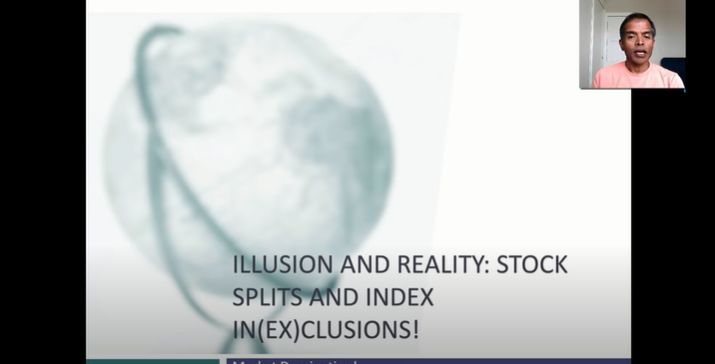In his latest presentation titled – Illusion, Perception and Reality: Stock Splits and Index Inclusions Aswath Damodaran discusses the effects of value, gap, and pricing events on a companies value and stock price. He makes the point that, “the reality is that a great deal of the price movement on a day-to-day basis has nothing to do with earnings, cash flows or risk.”. Here’s an excerpt from the presentation:
After big market movements, we are eager to look for explanations, fundamental reasons why a stock or stocks collectively moved on that day, but the reality is that a great deal of the price movement on a day-to-day basis has nothing to do with earnings, cash flows or risk. On August 31, this reality was brought home by two events, neither with a strong connection to fundamentals, that represented the news of the day and contributed to price movements. The first was that two of the highest profile stocks in the market, Apple and Tesla, had stock splits that day (August 31), though the market had been trading on the expectation of these stock splits, for weeks leading into the day. On the same day, the Dow 30, a hopelessly flawed, but still among the most followed indices in the market, also announced a major reshuffling, replacing Exxon Mobil, Pfizer and Raytheon, three of its components, with Honeywell, Amgen and Salesforce. That gave rise to a wave of speculation about whether these new entrants would be helped or hurt by their inclusion in the index. While it is easy to dismiss stock splits and index inclusions as non-events, that dismissal is contradicted by market behavior, which, rational or not, seems to view them as consequential.
Value, Price and the Gap
I have long argued that value and price, while used interchangeably by many, are different concepts, driven by different forces, and lead to different numbers.
If you are an investor, no matter what your philosophy, this picture should not surprise you, since every philosophy is built around beliefs about the value and price processes.
- A value-based investor, for instance, believes that value and price can diverge, often by large amounts and for long periods, but that the price will eventually converge on value, delivering profits to those with the patience to hold on to the investment.
- A trader, in contrast, has little interest in value and plays the pricing game, gauging momentum and mood shifts to make money, and using liquidity or the lack of it to magnify these gains.
- An efficient marketer may agree that the price and value processes can diverge, creating gaps, but also believes that investors are incapable of finding and taking advantage of the gaps.
When an event occurs, whether precipitated by the company or an outside force, it can play out in one of three ways. A value event changes cash flows, alters expected growth and/or impacts the uncertainty/risk in these cash flows, and by doing so, change a company’s value. A gap event does not change value, but is designed to get markets to notice mistakes that cause price to diverge from value, and to correct those mistakes, closing the gap. A pricing event is one designed to either alter mood and momentum or to change the liquidity characteristics of a company, causing price to change, even if that price change widens the gap with value. In the graph below, I have expanded the value and price distinction to include these events and the expected effects:
Without examples, these are abstractions, but before I cite examples for each, I want to emphasize that there are very few events that have only one effect, and that most have a dominant effect (on value, price or the gap) with secondary effects on the others.
You can watch the entire presentation here:
For all the latest news and podcasts, join our free newsletter here.
Don’t forget to check out our FREE Large Cap 1000 – Stock Screener, here at The Acquirer’s Multiple:





